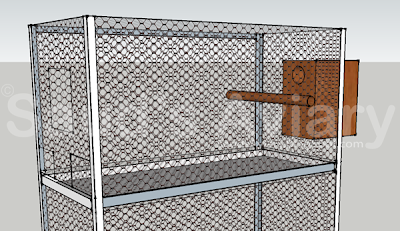Getting Started with Breeding Ringnecks

First of all you need to pick the right cage. Ringnecks require a minimum cage size of 24in x 24in x 48in. The front of the cage should be 24x24 with feeding stations. The depth should be 48inches with the nest box installed outside at the back of the cage. There should be a perch about 1.5-2in in diameter 6-8in from the back wall and just below the opening to the nest box. The logic behind such a setup is that the nest box should be farthest from human approach during feeding times. Birds feels secure in such an environment and are more likely to breed. The illustration below shows this setup. The mesh used for the cage should be rectangular weld mesh and not expanded metal mesh as shown in the picture. The nest box should be filled with white pine shavings 3in deep. The cage should be protected from direct wind and prolonged exposure to sun. While sunlight is great for birds, a shaded area in the cage should always be available to them. Once you have the setup in place, you ...
